Soaps & Detergents: Human Safety

To determine the safety of a cleaning product ingredient, industry scientists evaluate the toxicity of the ingredient. Toxicity is generally defined as any harmful effect of a chemical on a living organism, i.e., a human, an animal, a plant or a microorganism. Since all chemicals, including water (H2O), are toxic under certain conditions of exposure, scientists must consider a number of factors affecting exposure. These include the duration and frequency of exposure to the ingredient; the concentration of the ingredient at the time of exposure; and the route and manner in which the exposure occurs, e.g., eye, skin or ingestion. This information is essential whether assessing the effect on humans, animals, plants or microorganisms.

Because human safety and environmental evaluations consider different types of exposures, they are evaluated by different procedures. The principal steps in the assessment process are, however, the same. They involve:
- assembling existing data on toxicity and exposure;
- determining where new information is needed and, if necessary, carrying out appropriate studies; and
- determining whether predicted exposure levels are below levels that cause significant toxic effects.
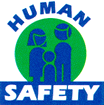 Medical science has long confirmed the important relationship between cleanliness and health. The regular use of cleaning products is fundamental to the health of our society and the well-being of its people.
Medical science has long confirmed the important relationship between cleanliness and health. The regular use of cleaning products is fundamental to the health of our society and the well-being of its people.Because cleaning products are part of our everyday lives, it is essential that they not present a significant risk to health. In considering the human safety of an individual ingredient or product, toxicologists (scientists who assess the safety of a chemical) are concerned with the effects from two types of exposures: intended and unintended. Intended exposures occur with use of a cleaning product according to the manufacturer's directions. Unintended exposures can result from misuse, through improper storage or by accidental contact, such as when a liquid detergent is splashed in the eye.
Hazards from these types of exposures are evaluated from information obtained through

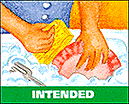 acute (short-term) and chronic (long-term) tests and through a review of existing data. Expected exposure routes are considered as part of this evaluation.
acute (short-term) and chronic (long-term) tests and through a review of existing data. Expected exposure routes are considered as part of this evaluation.Human safety evaluations begin with the specific ingredients and then move on to the whole product. The effects for all ingredients are considered as the product is formulated.
 Toxicologists compare the expected exposure to the expected effect during both product manufacture and use. How will workers be exposed in the plant? What is the intended use of the product? Is it to be diluted? Undiluted? Used daily in the home? Weekly in the workplace? Toxicologists also consider the expected effect of an unintended exposure. What is the potential hazard, for example, if a child drinks a product directly from the bottle?
Toxicologists compare the expected exposure to the expected effect during both product manufacture and use. How will workers be exposed in the plant? What is the intended use of the product? Is it to be diluted? Undiluted? Used daily in the home? Weekly in the workplace? Toxicologists also consider the expected effect of an unintended exposure. What is the potential hazard, for example, if a child drinks a product directly from the bottle?If this human safety evaluation indicates an unacceptable risk, it may be possible to make the risk smaller by changing the manufacturing process; reformulating to reduce or eliminate an ingredient contributing to the toxic effect; or using labeling or a child-resistant closure. If the risk cannot be reduced, the product will not be marketed.
Even though manufacturers formulate cleaning products to ensure that they are safe or
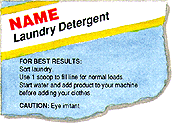 have very low risk, human health effects can still result from unintended exposure. To warn consumers about a specific hazard, household cleaning products carry cautionary labeling whenever necessary. For consumers, this is one of the most important features of the label.
have very low risk, human health effects can still result from unintended exposure. To warn consumers about a specific hazard, household cleaning products carry cautionary labeling whenever necessary. For consumers, this is one of the most important features of the label.Federal regulations govern how precautionary statements related to human safety are used on household cleaning product labels. The regulations require that statements follow a standard format. There is first a "signal word," followed by a short description of the potential hazard. The following chart shows the signal words - CAUTION or WARNING and DANGER - and what they mean:
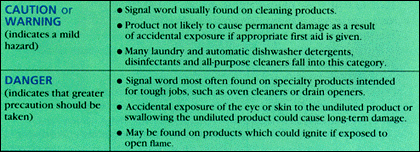
Along with the safety evaluation process and cautionary labeling, an extensive consumer education program on the proper use, storage and disposal of cleaning products supports the human safety efforts of the soap and detergent industry. In addition, the industry works closely with poison control centers to assure that, should an accidental exposure occur, treatment information is available to health care providers. Together, these activities enable consumers to use cleaning products with confidence in both their safety and performance.
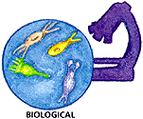 grease, from the wastewater by physical means, i.e., settling and flotation in tanks. The second step, called secondary treatment, removes the dissolved material by biological means, i.e., consumption by microorganisms. It is in the secondary treatment stage where the most important process in reducing the exposure concentration of detergent ingredients occurs. This is called biodegradation. Biodegradation describes how organic (carbon-containing) detergent ingredients, like surfactants, enzymes and fragrances, are broken down into carbon
grease, from the wastewater by physical means, i.e., settling and flotation in tanks. The second step, called secondary treatment, removes the dissolved material by biological means, i.e., consumption by microorganisms. It is in the secondary treatment stage where the most important process in reducing the exposure concentration of detergent ingredients occurs. This is called biodegradation. Biodegradation describes how organic (carbon-containing) detergent ingredients, like surfactants, enzymes and fragrances, are broken down into carbon 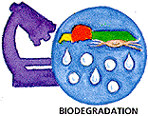 dioxide, water and minerals by the action of microorganisms such as bacteria. At this stage, biodegradation reduces the amount of detergent ingredients discharged into the environment to levels that do not present a risk to fish or other aquatic life. Any small amounts of chemicals which are not biodegraded or removed during sewage treatment are diluted in surface waters, soil and the ocean. They continue to biodegrade or be removed from water by attaching to solids, a process known as adsorption.
dioxide, water and minerals by the action of microorganisms such as bacteria. At this stage, biodegradation reduces the amount of detergent ingredients discharged into the environment to levels that do not present a risk to fish or other aquatic life. Any small amounts of chemicals which are not biodegraded or removed during sewage treatment are diluted in surface waters, soil and the ocean. They continue to biodegrade or be removed from water by attaching to solids, a process known as adsorption.S
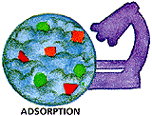 ome inorganic (not carbon-containing) detergent ingredients, such as phosphates, zeolites and some dyes, also attach to solids, and are further treated during processing of the biosolids (sludge) produced in primary and secondary treatment. Biosolids are often used as fertilizers and soil conditioners.
ome inorganic (not carbon-containing) detergent ingredients, such as phosphates, zeolites and some dyes, also attach to solids, and are further treated during processing of the biosolids (sludge) produced in primary and secondary treatment. Biosolids are often used as fertilizers and soil conditioners.Because of modern treatment methods, only an insignificant amount of the ingredients used to clean clothes, dishes, home and workplace surfaces actually reaches the environment. And that amount is at such levels as to not cause any adverse effects.
Improving Environmental Quality
The soap and detergent industry is committed to understanding the impact of its products and packages on the environment. With this understanding comes the ability to reduce their impact and improve their environmental quality.Manufacturers of cleaning products have been leaders in reducing packaging waste and encouraging sound waste disposal practices. Advances in technology have resulted in products that are more concentrated, products that combine two functions in one, products with refill packages and packages that use recycled materials. Concentrated products need less energy to manufacture and transport, and require less packaging. Multifunctional products eliminate the need for separate packages. Refill packages allow consumers to reuse primary packages many times, decreasing the amount of packaging used and the volume of trash generated. Plastic and paperboard that would otherwise be thrown away become usable materials through recycling.
 Through education and community programs, the soap and detergent industry helps consumers learn how to reduce waste and how best to dispose of it. Consumers are reminded that the environmentally wise way of handling any household cleaning product is to buy only the amount that can be used; to use it all up or give it away; and, if it must be disposed, to dispose of it properly. As a rule of thumb, products designed for use with water should be disposed of by pouring down the drain; solid products such as scouring pads should be put into the trash.
Through education and community programs, the soap and detergent industry helps consumers learn how to reduce waste and how best to dispose of it. Consumers are reminded that the environmentally wise way of handling any household cleaning product is to buy only the amount that can be used; to use it all up or give it away; and, if it must be disposed, to dispose of it properly. As a rule of thumb, products designed for use with water should be disposed of by pouring down the drain; solid products such as scouring pads should be put into the trash.A promising method under development for improving
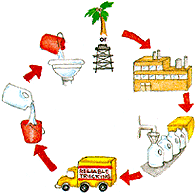 the environmental quality of a product is life cycle assessment (LCA). LCA describes a "cradle-to-grave" look at all the environmental impacts of a product and its package, from acquiring raw materials through manufacture and distribution to consumer use and disposal. One advantage of LCA is that it can determine whether reducing an environmental impact in one area, such as manufacturing, shifts the impact to another, such as disposal. LCA also helps to identify where environmental improvement efforts should be focused.
the environmental quality of a product is life cycle assessment (LCA). LCA describes a "cradle-to-grave" look at all the environmental impacts of a product and its package, from acquiring raw materials through manufacture and distribution to consumer use and disposal. One advantage of LCA is that it can determine whether reducing an environmental impact in one area, such as manufacturing, shifts the impact to another, such as disposal. LCA also helps to identify where environmental improvement efforts should be focused.Sound scientific information provides the foundation for the soap and detergent industry's commitment to safety. The industry maintains this commitment without compromising product performance, convenience or cost-effectiveness.